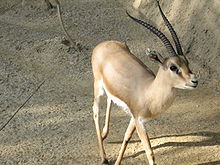Gazella
| Gazelle Temporal range: Pliocene to recent |
|
|---|---|
 |
|
| Rhim gazelle | |
| Scientific classification | |
| Kingdom: | Animalia |
| Phylum: | Chordata |
| Class: | Mammalia |
| Order: | Artiodactyla |
| Family: | Bovidae |
| Subfamily: | Antilopinae |
| Tribe: | Antilopini |
| Genus: |
Gazella Blainville, 1816 |
| Species | |
|
Several, see text |
|
Several, see text
A gazelle is any of many antelope species in the genus Gazella or formerly considered to belong to it. Six species are included in two genera, Eudorcas and Nanger, which were formerly considered subgenera. The genus Procapra has also been considered a subgenus of Gazella, and its members are also referred to as gazelles, though they are not dealt with in this article. Gazelles are known as swift animals. Some are able to run at bursts as high as 100 km/h (60 mph) or run at a sustained speed of 50 km/h (30 mph). Gazelles are found mostly in the deserts, grasslands, and savannas of Africa; but they are also found in southwest and central Asia and the Indian subcontinent. They tend to live in herds, and eat less coarse, easily digestible plants and leaves.
Gazelles are rather small antelopes, most standing 60–110 cm (2–3.5 ft) high at the shoulder, and are generally fawn-colored.
The gazelle genera are Gazella, Eudorcas, and Nanger. The taxonomy of these genera is a confused one, and the classification of species and subspecies has been an unsettled issue. Currently, the genus Gazella is widely considered to contain about 10 species. Four further species are extinct: the red gazelle, the Arabian gazelle, the Queen of Sheba's gazelle, and the Saudi gazelle. Most surviving gazelle species are considered threatened to varying degrees. Closely related to the true gazelles are the Tibetan and Mongolian gazelles (species of the genus Procapra), the blackbuck of Asia, and the African springbok.
...
Wikipedia
